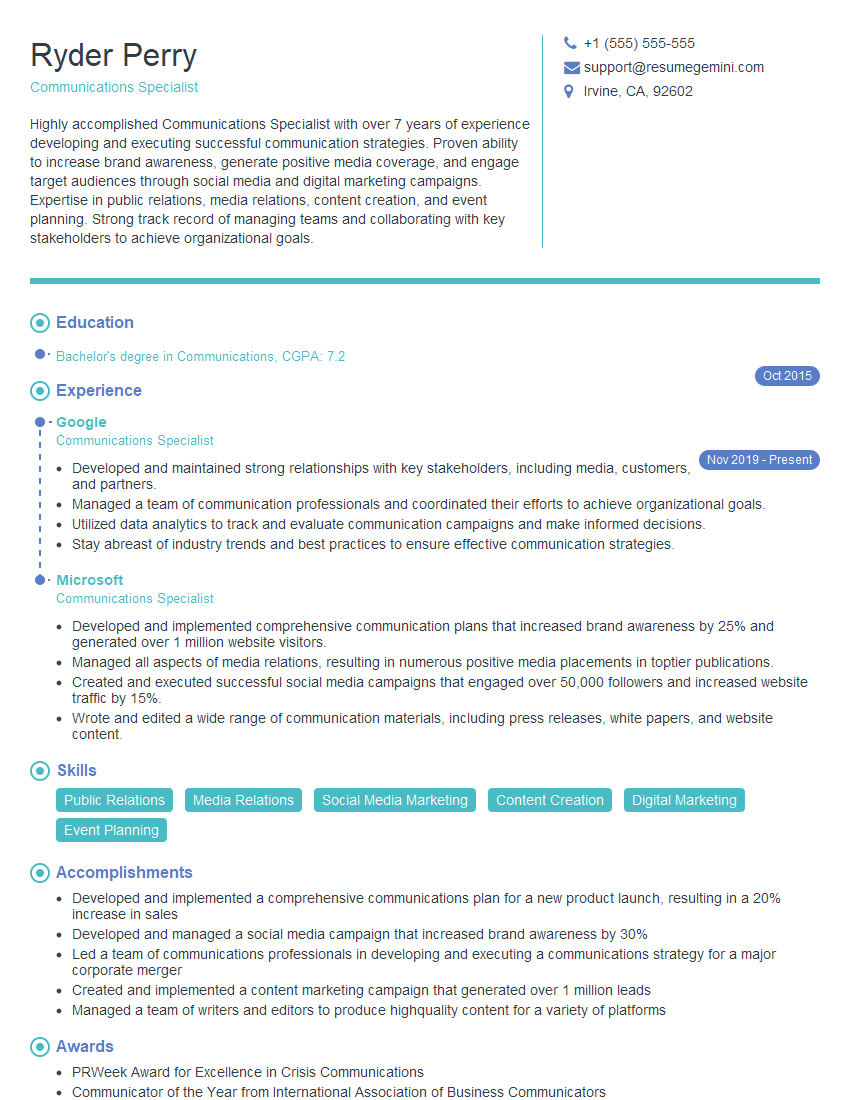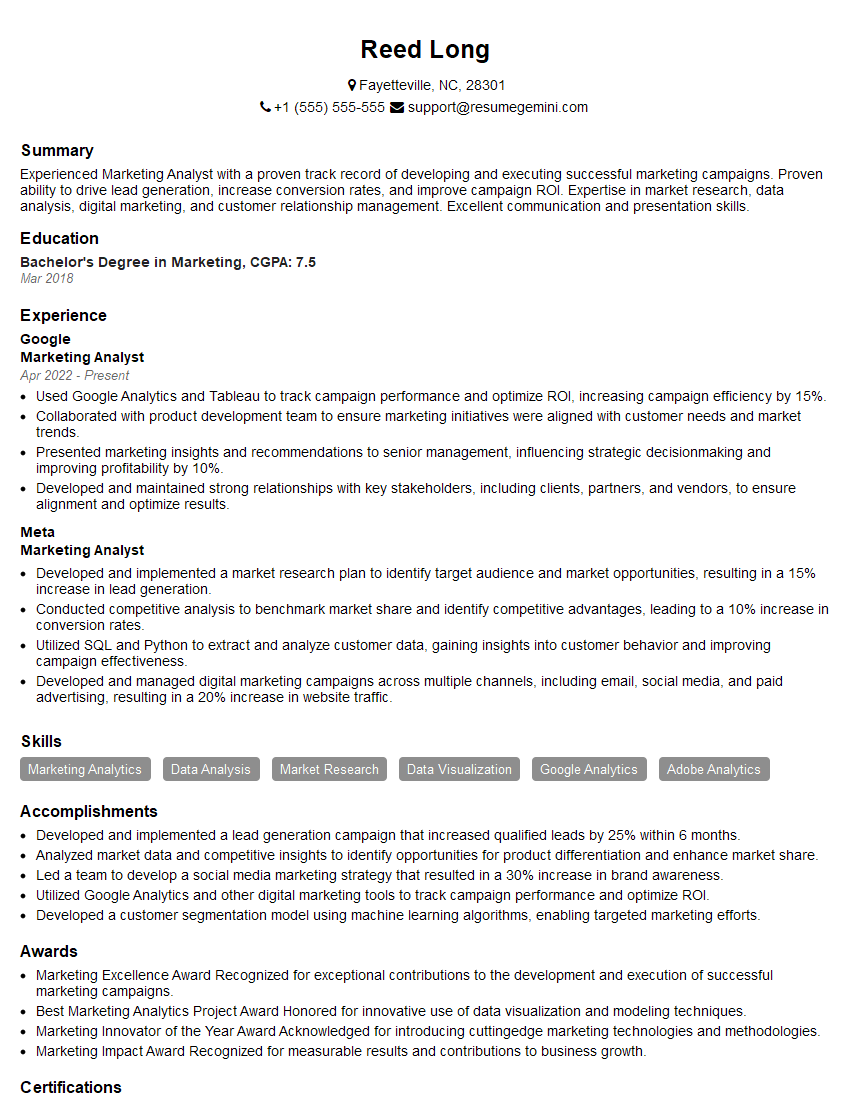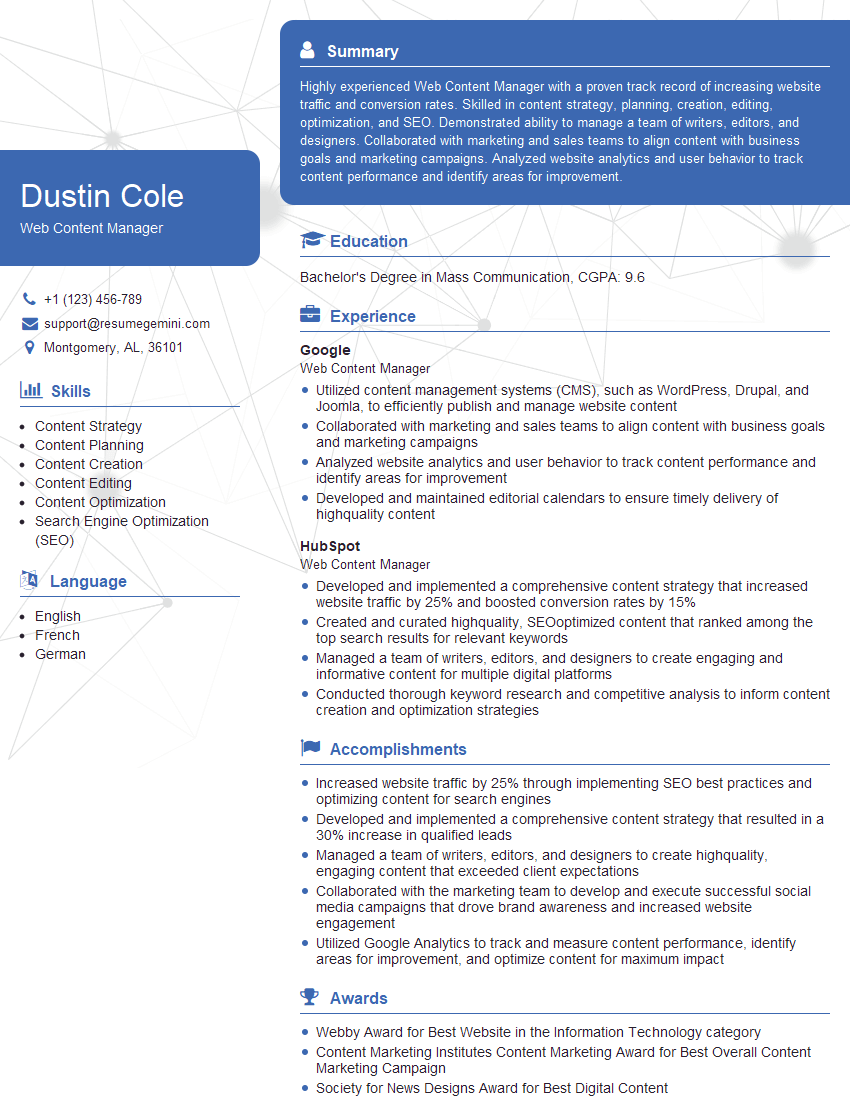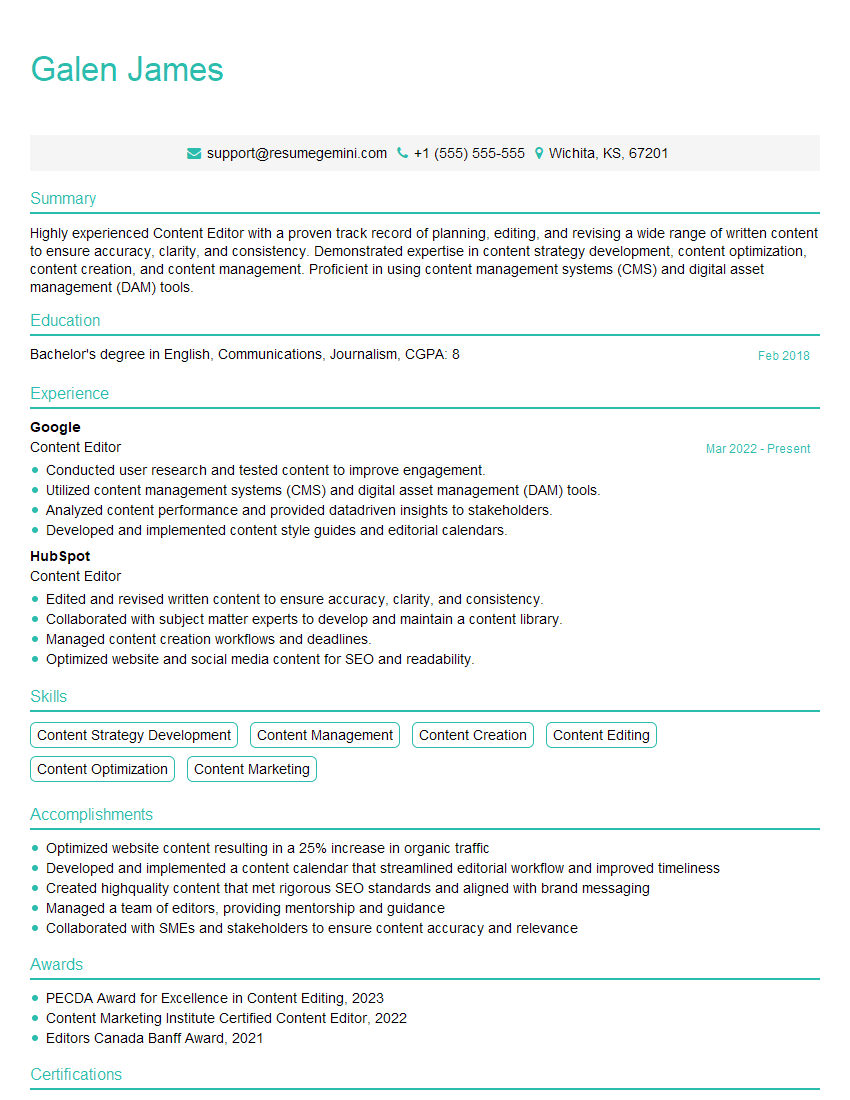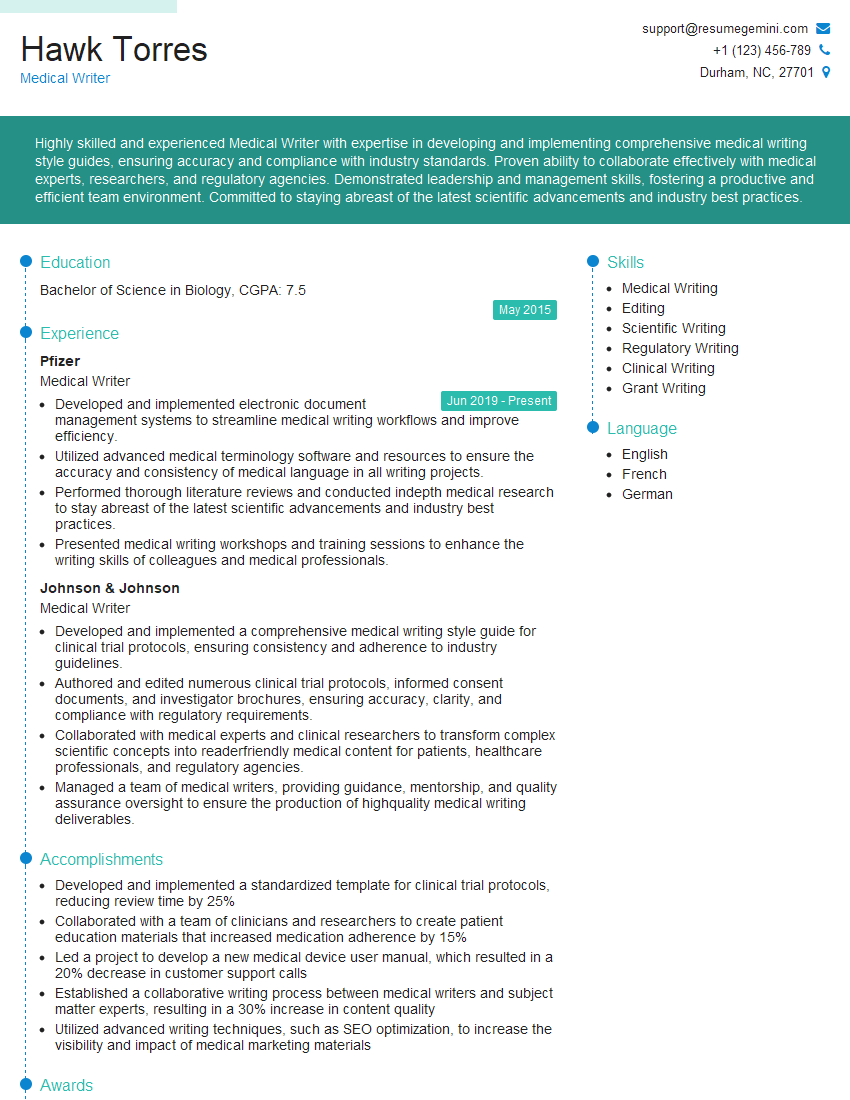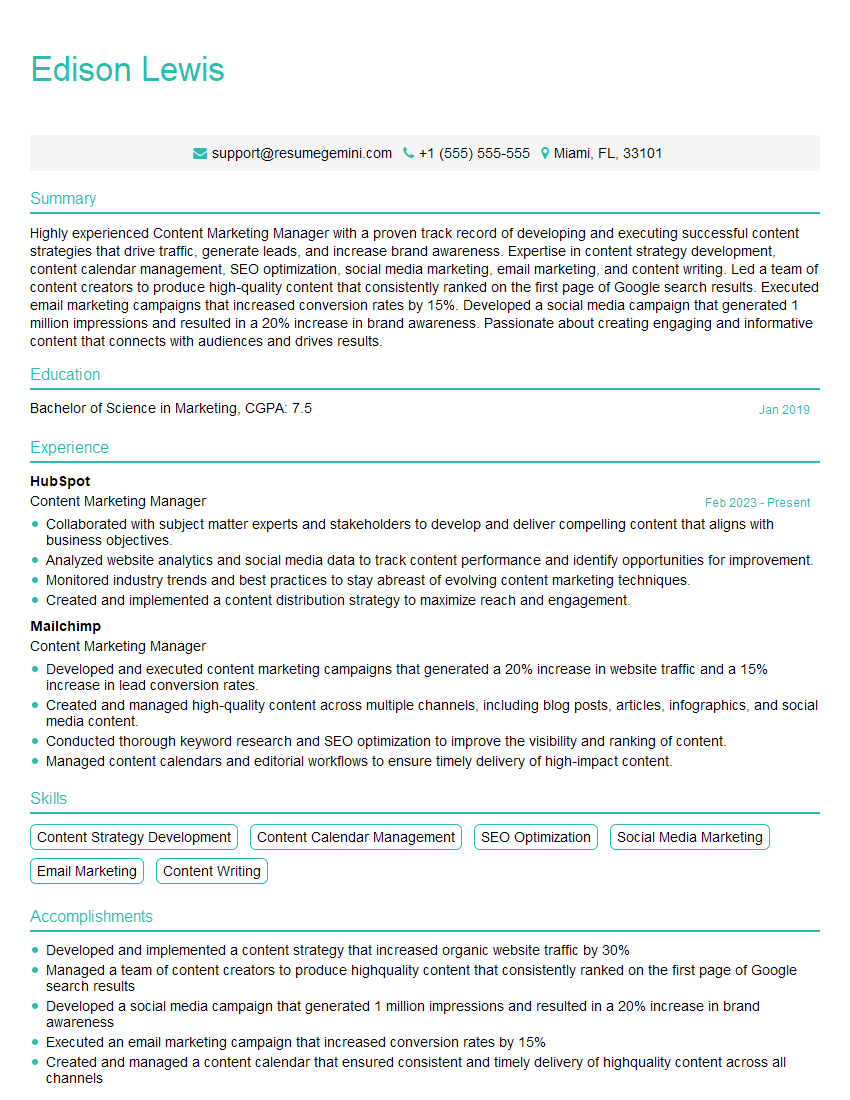Preparation is the key to success in any interview. In this post, we’ll explore crucial Content Analysis and Evaluation interview questions and equip you with strategies to craft impactful answers. Whether you’re a beginner or a pro, these tips will elevate your preparation.
Questions Asked in Content Analysis and Evaluation Interview
Q 1. Explain the difference between qualitative and quantitative content analysis.
Qualitative and quantitative content analysis differ fundamentally in their approach to data and the types of conclusions they draw. Think of it like this: qualitative analysis is like exploring a landscape with a paintbrush, capturing the nuances and textures of the scene, while quantitative analysis is like surveying the same landscape with a ruler and measuring its precise dimensions.
Qualitative Content Analysis: This approach focuses on understanding the meaning and interpretations within textual or visual data. It’s exploratory and interpretive, often involving detailed examination of themes, concepts, and patterns that emerge from the data. The results are typically descriptive and rich in detail, focusing on the ‘why’ behind the data. For example, analyzing interview transcripts to understand public perception of a new policy would be a qualitative approach.
Quantitative Content Analysis: This method involves counting and measuring the frequency of specific words, phrases, or concepts within a dataset. It’s focused on quantifiable aspects and often employs statistical analysis to identify trends and relationships. The goal is to establish numerical representations of the data, providing objective measurements of content features. Analyzing the number of times a particular brand is mentioned in social media posts to assess brand awareness would be a quantitative approach.
In short, qualitative analysis prioritizes depth and richness of interpretation, while quantitative analysis emphasizes numerical measurements and statistical analysis.
Q 2. Describe your experience with various content analysis methods (e.g., thematic analysis, discourse analysis).
Throughout my career, I’ve extensively utilized a variety of content analysis methods. My experience spans across several approaches, each tailored to specific research questions and datasets.
- Thematic Analysis: I’ve employed thematic analysis in several projects, identifying recurring patterns and themes within large datasets. For instance, I analyzed a collection of customer reviews to identify recurring themes related to product satisfaction and areas for improvement. This involved coding the data, identifying recurring themes, and developing a thematic map to illustrate the relationships between themes.
- Discourse Analysis: This method has been invaluable in examining the power dynamics and social constructions present in communication. In one project, I analyzed political speeches to identify the persuasive techniques used and how they shaped public opinion. Discourse analysis allows for a deeper understanding of the context and implications of communication.
- Sentiment Analysis: I’ve used sentiment analysis to gauge the emotional tone of text data. For example, I analyzed social media posts to determine public sentiment towards a specific event. Tools and techniques ranging from simple keyword searches to sophisticated natural language processing algorithms were employed.
My approach is always guided by the research question and the nature of the data. The selection of a particular method is driven by its suitability for providing insightful answers to the research questions at hand.
Q 3. How do you determine the appropriate sample size for a content analysis project?
Determining the appropriate sample size for content analysis is crucial for ensuring the reliability and generalizability of the findings. There’s no one-size-fits-all answer; it depends on several factors.
- Research Question: A more complex research question might require a larger sample size to ensure sufficient data for in-depth analysis.
- Data Heterogeneity: If the data is highly diverse, a larger sample size is necessary to capture the full range of variation.
- Desired Precision: Higher precision in the results necessitates a larger sample size.
- Resource Constraints: Time and budget limitations often influence the feasible sample size.
Techniques like power analysis can help estimate the required sample size based on the anticipated effect size and desired level of statistical significance. However, in qualitative analysis, saturation (the point at which new data doesn’t reveal new themes) often guides sample size decisions. In practice, I often start with a smaller pilot sample to refine the coding scheme and then increase the sample size until data saturation is reached.
Q 4. What software or tools have you used for content analysis?
My experience encompasses a range of software and tools for content analysis, each offering unique features and capabilities. The choice depends largely on the type of analysis, data format, and available resources.
- NVivo: A powerful qualitative data analysis software used for managing, coding, and analyzing large datasets. I’ve used it for thematic analysis and mixed-methods studies.
- Atlas.ti: Similar to NVivo, it’s a robust qualitative data analysis software for coding, memoing, and visualizing relationships within data.
- MAXQDA: Another popular qualitative data analysis software with features for coding, analyzing, and visualizing qualitative data.
- Python with libraries like NLTK and spaCy: These are invaluable for quantitative analysis tasks such as sentiment analysis, topic modeling, and text classification. I’ve used these to build custom analysis pipelines for specific research needs.
- Excel and SPSS: For simpler quantitative content analysis projects, Excel and SPSS can be effective tools for data organization and basic statistical analysis.
My proficiency extends beyond these tools. I adapt my approach and select the most appropriate technology based on the unique requirements of each project.
Q 5. How do you ensure the reliability and validity of your content analysis findings?
Ensuring the reliability and validity of content analysis findings is paramount. It’s essential to minimize bias and ensure that the results accurately reflect the data.
- Reliability: This refers to the consistency of the findings. To enhance reliability, I employ rigorous coding procedures, utilize multiple coders with inter-rater reliability checks, and carefully document all decisions made during the analysis process.
- Validity: This refers to the accuracy and truthfulness of the findings. Strategies for enhancing validity include using multiple data sources to triangulate findings, employing a clear and well-defined coding scheme, and providing detailed justifications for all analytical choices.
Throughout the analysis, a clear audit trail is maintained, documenting all steps taken, making the process transparent and reproducible. A robust methodology significantly contributes to the confidence that can be placed in the results.
Q 6. Explain the concept of inter-rater reliability and how it’s achieved.
Inter-rater reliability is a crucial measure of the consistency of coding across multiple raters. It ensures that different analysts interpret the data similarly, minimizing subjective bias. Imagine you are measuring the height of a building: different people using the same measuring tape should get approximately the same result. Similarly, multiple coders applying the same coding scheme to the same data should arrive at similar results.
Achieving high inter-rater reliability involves:
- Detailed Coding Scheme: Creating a clear and comprehensive coding scheme with detailed definitions for each code. Ambiguity must be minimized.
- Coder Training: Providing thorough training to all coders, ensuring they understand the coding scheme and its application.
- Pilot Testing: Conducting a pilot test with a small subset of data to identify and resolve any discrepancies in coding before analyzing the full dataset.
- Inter-rater Reliability Calculation: Calculating inter-rater reliability using statistical measures like Cohen’s Kappa or Krippendorff’s alpha. These metrics quantify the agreement between coders.
- Iteration and Refinement: Addressing any disagreements between coders by discussing their interpretations and refining the coding scheme as needed.
High inter-rater reliability demonstrates the objectivity and robustness of the coding process, increasing confidence in the analysis results.
Q 7. How do you handle missing data or inconsistencies in your data set during content analysis?
Handling missing data or inconsistencies is a critical aspect of responsible content analysis. Ignoring these issues can bias the results.
- Missing Data: The approach to missing data depends on the extent and nature of the missingness. If it is minimal and random, it may not significantly affect the analysis. However, if it’s substantial or non-random, strategies such as imputation (replacing missing values with estimated values) or analysis techniques robust to missing data may be necessary. The decision should be justified and transparently documented.
- Inconsistencies: Inconsistencies can arise from errors in data collection or ambiguity in the data. Careful review of the data is essential. If the inconsistencies are minor and easily resolved (e.g., typos), they can be corrected. If the inconsistencies reflect genuine ambiguities or complexities in the data, they should be addressed through thoughtful analysis and interpretation. This might involve creating separate codes for inconsistent categories or explicitly discussing the ambiguity in the findings.
Transparency is key. All decisions made in handling missing data or inconsistencies should be clearly documented and justified, allowing others to understand and potentially replicate the analysis. It’s important to acknowledge the limitations imposed by missing data or inconsistencies when interpreting results.
Q 8. Describe your experience with coding schemes and how you develop them.
Coding schemes are the heart of content analysis. They’re essentially a structured set of rules that dictate how we categorize and quantify the content we’re analyzing. Think of them as a detailed instruction manual for analyzing text, images, or videos. Developing a robust coding scheme requires careful planning and iterative refinement.
My approach begins with clearly defining the research question. What are we trying to understand? Once that’s clear, I identify the key concepts or variables that need to be coded. For example, if analyzing customer reviews for a new product, we might code for sentiment (positive, negative, neutral), specific product features mentioned, and overall satisfaction. I then create a detailed codebook that precisely defines each code and provides examples of what falls under each category. This avoids ambiguity and ensures inter-rater reliability (multiple coders getting consistent results).
Let’s say we’re analyzing tweets about a specific brand. A codebook might define “positive sentiment” as tweets containing words like “love,” “great,” or “amazing,” while “negative sentiment” includes words like “terrible,” “awful,” or “disappointing.” Each code is given a numerical value for easier quantitative analysis. After creating the codebook, pilot testing is essential. A small subset of the data is coded by multiple coders to check for consistency and refine the scheme where needed. This iterative process helps to produce a reliable and valid coding scheme.
Q 9. How do you identify and address biases in content analysis?
Bias in content analysis is a serious concern, as it can significantly skew results. It can stem from several sources: the researcher’s own preconceptions, inherent biases in the data itself, or limitations in the coding scheme. Identifying and addressing these biases is crucial for ensuring the validity and trustworthiness of the analysis.
Firstly, I employ rigorous self-reflection to recognize my own potential biases. For instance, if analyzing political news, I’d acknowledge my personal political leanings and actively strive for objectivity. Secondly, I meticulously review the data sources to identify potential biases in the data collection process. For example, social media data might over-represent certain demographics and viewpoints. I might use techniques like stratified sampling to account for this.
Regarding the coding scheme, clear operational definitions and extensive pilot testing are critical. The codebook should be reviewed by other researchers to ensure it is free from subjective interpretations. Using multiple coders, and calculating inter-rater reliability statistics (like Cohen’s Kappa) helps identify discrepancies and ensures the consistency of the coding process. Finally, I always present any limitations or potential biases in the analysis within the final report, promoting transparency and critical engagement with the findings.
Q 10. How do you interpret and present the results of your content analysis?
Interpreting and presenting content analysis results demands a clear understanding of both quantitative and qualitative aspects. While coding produces numerical data, we must always consider the context and meaning behind those numbers.
My approach involves a multi-faceted presentation. I start by summarizing the key findings in plain language, avoiding technical jargon. For example, instead of saying “The sentiment score for brand X was 0.75,” I’d say, “Customer reviews showed overwhelmingly positive sentiment for brand X.” I then present quantitative results using tables, charts, and graphs to highlight key trends and patterns. For instance, a bar chart would show the percentage of positive, negative, and neutral reviews.
Equally important is incorporating qualitative data – direct quotes or excerpts from the content – to illustrate the findings and add depth. This helps readers connect with the data on a human level. The presentation is structured logically, progressing from a general overview of the findings to a more detailed discussion of specific themes and patterns. The report always includes a description of the methodology, limitations, and potential implications of the findings.
Q 11. What are some common challenges in content analysis and how have you overcome them?
Content analysis, while powerful, presents several challenges. One is the sheer volume of data, especially with social media or large text corpora. Another is coder fatigue and maintaining consistency over long periods. Then there’s the issue of inter-rater reliability and ensuring that different coders interpret the codes in the same way.
To address data volume, I utilize computer-assisted qualitative data analysis software (CAQDAS) packages. These tools help automate aspects of the coding process, allowing for efficient analysis of large datasets. For coder fatigue, I employ strategies such as working in shorter sessions, taking regular breaks, and having multiple coders code a sample of the data independently. Differences are then discussed and resolved collaboratively.
Inter-rater reliability is consistently monitored throughout the project. Cohen’s Kappa statistic provides a quantitative measure of agreement between coders. If reliability is low, I review the codebook with the coders, clarify ambiguities, and re-code a portion of the data until satisfactory agreement is achieved. Addressing these challenges proactively ensures the quality and credibility of the analysis.
Q 12. How do you use content analysis to inform content strategy?
Content analysis is an invaluable tool for informing content strategy by providing data-driven insights into audience preferences, effective communication strategies, and overall content performance.
For example, by analyzing existing content (blog posts, social media posts, customer reviews), we can identify which topics resonate most with the audience, what type of language or style is most engaging, and what channels are most effective. This informs the creation of new content that is more likely to be successful. Let’s say a content analysis of customer reviews reveals a strong interest in a specific product feature. This insight guides the creation of targeted content highlighting that feature, potentially driving sales and improving customer satisfaction.
Furthermore, analysis of competitor content can reveal best practices and identify opportunities to differentiate. Understanding the language, tone, and overall style of successful competitors can inform our own content strategy. In short, content analysis bridges the gap between intuition and data, allowing for a more strategic and effective approach to content creation and distribution.
Q 13. How do you measure the effectiveness of content marketing campaigns using content analysis?
Measuring the effectiveness of content marketing campaigns using content analysis involves tracking key metrics related to audience engagement, lead generation, and ultimately, business outcomes.
We can analyze website traffic data to determine which pieces of content attract the most visitors and how long they stay on the page. This reveals which content is most engaging. Analyzing social media metrics provides insights into how audiences interact with content: likes, shares, comments, and retweets indicate resonance and virality. Analyzing leads generated from content (e.g., from forms on landing pages or links in blog posts) measures the content’s ability to drive conversions.
Ultimately, the effectiveness is assessed against predefined business goals. For example, if the goal was increased brand awareness, we look for increases in social media mentions and website traffic. If the goal was lead generation, we track the number of qualified leads generated. By combining quantitative data (website analytics, social media metrics) with qualitative data (e.g., analyzing customer feedback on specific content pieces), we can gain a comprehensive understanding of the campaign’s impact and inform future strategies.
Q 14. Describe your experience with analyzing social media data for content insights.
Analyzing social media data for content insights is a powerful way to understand audience sentiment, identify trending topics, and gain a deeper understanding of customer preferences.
My experience involves using both qualitative and quantitative methods. Qualitatively, I analyze the content of posts, comments, and tweets to understand the themes, sentiments, and language used by users. This helps to identify key concerns, emerging trends, and overall perceptions of the brand or product. Quantitatively, I use social listening tools to track mentions, engagement rates, sentiment scores, and other metrics. This provides a broader picture of audience reach, engagement, and overall impact of the content.
For instance, by tracking hashtags and keywords, we can identify topics gaining traction amongst the target audience. Sentiment analysis reveals the overall tone of conversations, indicating whether the content is perceived positively, negatively, or neutrally. By combining both qualitative and quantitative data, a comprehensive understanding of audience preferences, concerns, and overall sentiment is achieved, informing the creation of more effective social media content.
Q 15. How do you use content analysis to improve user experience?
Content analysis plays a crucial role in enhancing user experience. By systematically examining user-generated content—reviews, comments, social media posts, etc.—we can uncover valuable insights into user preferences, pain points, and expectations. This understanding directly informs design and content strategy decisions.
For example, analyzing customer reviews of a website might reveal recurring complaints about navigation. This information indicates a need for website redesign focusing on improved site architecture and intuitive navigation. Similarly, analyzing social media conversations about a product can reveal unmet needs or desires that can be addressed through new features or marketing messages.
Essentially, content analysis transforms qualitative data into actionable insights, enabling businesses to create a more user-centric and satisfying experience.
Career Expert Tips:
- Ace those interviews! Prepare effectively by reviewing the Top 50 Most Common Interview Questions on ResumeGemini.
- Navigate your job search with confidence! Explore a wide range of Career Tips on ResumeGemini. Learn about common challenges and recommendations to overcome them.
- Craft the perfect resume! Master the Art of Resume Writing with ResumeGemini’s guide. Showcase your unique qualifications and achievements effectively.
- Don’t miss out on holiday savings! Build your dream resume with ResumeGemini’s ATS optimized templates.
Q 16. How do you incorporate content analysis into SEO strategies?
Content analysis is fundamental to effective SEO strategies. It helps us understand what keywords and topics resonate most with our target audience. By analyzing competitor content and identifying relevant search terms, we can optimize our own content to rank higher in search engine results pages (SERPs).
For instance, we might analyze competitor blogs to identify keywords they are ranking for. This helps us understand the search landscape and identify gaps in keyword coverage for our own content. Further, analyzing user search queries related to our industry allows us to create content that directly addresses those searches, thereby improving organic visibility.
In essence, content analysis facilitates a data-driven approach to SEO, ensuring that our content is both relevant and optimized for search engines.
Q 17. What metrics do you use to evaluate the quality and effectiveness of content?
Evaluating content effectiveness requires a multifaceted approach, going beyond simple metrics like views or shares. We use a combination of quantitative and qualitative metrics. Quantitative metrics include:
- Website Traffic & Engagement: Page views, time on page, bounce rate, click-through rates (CTR).
- Social Media Engagement: Shares, likes, comments, mentions.
- Conversion Rates: The percentage of visitors who complete a desired action (e.g., purchase, sign-up).
Qualitative metrics include:
- Sentiment Analysis: Gauging the overall emotional tone of comments and reviews (positive, negative, neutral).
- Content Quality Assessment: Evaluating readability, clarity, accuracy, and relevance to the target audience.
- User Feedback: Directly soliciting feedback through surveys, interviews, or focus groups.
By combining both quantitative and qualitative data, we obtain a comprehensive understanding of content performance and identify areas for improvement.
Q 18. How do you identify keywords relevant to content analysis?
Identifying relevant keywords for content analysis is a multi-step process. It begins with understanding the subject matter and target audience. We then employ various techniques:
- Keyword Research Tools: Utilizing tools like SEMrush, Ahrefs, or Google Keyword Planner to identify high-volume, low-competition keywords.
- Competitor Analysis: Examining the keywords used by competitors to understand the search landscape and identify potential opportunities.
- User Search Queries: Analyzing search terms used by users related to the subject matter, often using Google Search Console data.
- Content Analysis of Existing Material: Examining previously successful content to determine the keywords that were most effective.
The selection process ensures we focus on keywords that are relevant, have sufficient search volume, and align with the overall content strategy.
Q 19. Explain your experience in analyzing large datasets for content insights.
My experience with large datasets involves leveraging sophisticated analytical tools and techniques. I’ve worked with datasets containing millions of social media posts, customer reviews, and news articles. To process this data efficiently, I use:
- Natural Language Processing (NLP): For tasks like text cleaning, sentiment analysis, and topic modeling.
- Machine Learning (ML): For tasks like classification, clustering, and prediction.
- Big Data Tools: Such as Hadoop, Spark, or cloud-based platforms like AWS or Azure for data storage, processing, and analysis.
For example, in one project, I used NLP techniques to analyze a large dataset of customer reviews to identify key themes and sentiments related to a product. This information was then used to improve the product and refine marketing messaging.
Q 20. What is your process for defining the scope of a content analysis project?
Defining the scope of a content analysis project involves a structured approach to ensure clarity and focus. This typically includes:
- Research Questions: Clearly articulating the specific questions the analysis seeks to answer.
- Data Sources: Identifying the specific data sources to be analyzed (e.g., specific websites, social media platforms, etc.).
- Sampling Method: Determining the appropriate sampling technique to select a representative subset of data from the larger population, if needed.
- Coding Scheme: Developing a systematic approach to categorizing and classifying the data based on predefined variables and themes.
- Timeframe: Establishing a clear timeframe for the project.
Thorough scoping helps avoid scope creep and ensures the project stays on track and within budget.
Q 21. How do you ensure the ethical considerations are addressed in content analysis projects?
Ethical considerations are paramount in content analysis. These include:
- Informed Consent: Obtaining consent from individuals whose data is being analyzed, especially if the data is personally identifiable.
- Data Privacy: Protecting the privacy of individuals whose data is being analyzed by anonymizing data where possible and adhering to relevant data protection regulations (e.g., GDPR).
- Data Security: Implementing appropriate security measures to protect the data from unauthorized access and breaches.
- Bias Awareness: Being mindful of potential biases in the data and the analysis process, actively seeking to mitigate them.
- Transparency: Clearly documenting the methodology, data sources, and limitations of the analysis to promote transparency and reproducibility.
By addressing these ethical considerations, we ensure responsible and trustworthy content analysis practices.
Q 22. Describe a time you had to defend your content analysis findings.
Defending content analysis findings often involves anticipating potential critiques and having robust methodological justifications. In one project analyzing social media sentiment towards a new product launch, my team found surprisingly negative feedback despite positive initial marketing campaigns. The client challenged our findings, questioning the representativeness of our sample and the objectivity of our coding scheme.
To defend our analysis, we presented a detailed methodology report. This included a clear description of our sampling strategy (stratified random sampling across different demographics), the inter-coder reliability scores demonstrating high agreement among coders (above 0.8 Kappa), and a thorough explanation of our coding scheme with specific examples. We also addressed the client’s concerns directly, acknowledging the limitations of our sample and offering suggestions for future research to address potential biases. Ultimately, the transparency and rigor of our methodology convinced the client of the validity of our findings, leading to a revised marketing strategy.
Q 23. How do you stay updated with the latest trends and techniques in content analysis?
Staying current in content analysis requires a multi-pronged approach. I regularly read peer-reviewed journals like Qualitative Health Research and Journal of Communication, focusing on articles exploring new methods and applications. I also actively participate in online communities and attend conferences focused on data science and social science methodologies. This allows me to learn about cutting-edge techniques like sentiment analysis using machine learning, network analysis for understanding information diffusion, and the application of new software packages like R and Python for qualitative and quantitative content analysis.
Furthermore, I routinely explore online resources such as blogs and webinars offered by leading universities and research institutions. This informal learning complements the more formal academic literature, providing practical insights and real-world case studies that enrich my understanding of the field.
Q 24. What are some limitations of content analysis?
Content analysis, while powerful, has inherent limitations. One key limitation is subjectivity. Interpreting text or images can be influenced by the researcher’s biases, leading to potential misinterpretations. For instance, coding the sentiment of a tweet as ‘positive’ or ‘negative’ can be ambiguous, requiring strict coding guidelines and inter-coder reliability checks.
Another limitation is the potential for sampling bias. If the sample of content analyzed is not representative of the larger population, the findings may not be generalizable. For example, analyzing only positive reviews on a product website would paint a misleading picture of overall customer sentiment. Finally, content analysis can be time-consuming and resource-intensive, particularly for large datasets requiring manual coding. It’s crucial to acknowledge these limitations and employ strategies to mitigate them, such as using multiple coders, employing rigorous sampling techniques, and clearly documenting the methodology.
Q 25. How do you integrate content analysis with other data analysis methods?
Content analysis is often most powerful when integrated with other data analysis methods. For example, combining content analysis with network analysis can reveal how information spreads through online communities. Imagine analyzing news articles about a specific event (content analysis) and simultaneously mapping the relationships between the sources citing each other (network analysis). This combined approach reveals both the content of the narrative and the structure of its dissemination.
Similarly, integrating content analysis with quantitative data, such as website traffic or sales figures, provides richer insights. Analyzing the content of customer reviews (content analysis) alongside sales data can uncover connections between specific product features mentioned and actual purchasing behavior. This triangulation of methods strengthens the validity and interpretation of results.
Q 26. Explain your understanding of different sampling techniques in content analysis.
Sampling in content analysis is crucial for managing large datasets and ensuring representativeness. Several techniques exist, each with strengths and weaknesses:
- Random sampling: Each unit of content has an equal chance of being selected, ensuring unbiased representation. However, it might not be feasible if the dataset is poorly organized.
- Stratified random sampling: The dataset is divided into strata (e.g., demographic groups), and random sampling is performed within each stratum. This ensures representation from all relevant groups.
- Systematic sampling: Selecting every nth unit from the dataset. Simple to implement but can be problematic if there’s a pattern in the data that aligns with the sampling interval.
- Purposive sampling: Selecting specific units based on predefined criteria, useful for focused research questions. For example, selecting only tweets mentioning a specific hashtag.
- Snowball sampling: Identifying initial units and then using them to find more related units. Useful for hard-to-reach populations but risks bias.
The choice of sampling technique depends on the research question, the nature of the data, and available resources. A clear rationale for the chosen method is essential for ensuring the reliability and validity of the analysis.
Q 27. Describe your experience with using content analysis for competitive analysis.
I’ve extensively used content analysis for competitive analysis, particularly in marketing research. One project involved analyzing the marketing messages of three competing companies in the fitness app market. We analyzed their social media posts, website content, and app store descriptions to understand their brand positioning, key selling points, and target audience.
We used a combination of qualitative and quantitative techniques. Qualitatively, we coded the content for themes, identifying key messages and brand personality. Quantitatively, we measured the frequency of specific keywords and the overall sentiment expressed in their communications. This analysis revealed key differences in their marketing strategies and allowed us to identify opportunities for our client to differentiate themselves within the market. The findings informed the development of a targeted marketing campaign that leveraged the client’s unique strengths.
Q 28. How do you adapt your content analysis approach to different types of content (e.g., text, images, videos)?
Adapting content analysis to different content types requires adjusting the methods and tools used. For text-based content, methods like word frequency analysis, sentiment analysis, and thematic analysis are common. Software like NVivo or Atlas.ti can facilitate these analyses.
For image analysis, techniques like visual content analysis might be used, focusing on color palettes, object frequency, and visual metaphors. Software capable of image recognition and automated tagging can help manage large image datasets. For video analysis, techniques might include analyzing transcripts, visual elements, and audio features. The process often involves combining manual coding with automated tools for transcription and sentiment analysis of speech.
In each case, the chosen methods should align with the research question and the specific characteristics of the content being analyzed. This necessitates a flexible approach, integrating both qualitative and quantitative techniques where appropriate.
Key Topics to Learn for Content Analysis and Evaluation Interview
- Qualitative vs. Quantitative Analysis: Understanding the differences and appropriate applications of each approach in analyzing various content types (text, images, videos).
- Content Coding and Categorization Schemes: Developing and applying consistent coding frameworks for accurate and reliable data extraction. Consider practical applications like sentiment analysis or thematic analysis.
- Reliability and Validity in Content Analysis: Understanding the importance of inter-rater reliability and the various methods to ensure the accuracy and trustworthiness of your analysis.
- Software and Tools for Content Analysis: Familiarity with commonly used software (mentioning categories rather than specific tools) for qualitative and quantitative analysis, including their strengths and limitations.
- Interpreting and Presenting Findings: Effectively communicating your analysis results through clear, concise reports and visualizations, tailoring your presentation to different audiences.
- Ethical Considerations in Content Analysis: Addressing issues of bias, privacy, and responsible data handling in your research and analysis.
- Application to Specific Industries: Explore how content analysis is applied in different fields like marketing, social media, public relations, or academic research. Develop examples from your experience.
- Problem-solving in Content Analysis: Discuss strategies for handling challenges like incomplete data, inconsistent coding, or ambiguous content. Prepare to discuss your approaches to resolving these issues.
Next Steps
Mastering content analysis and evaluation opens doors to exciting career opportunities across diverse industries. Proficiency in this skill demonstrates valuable analytical abilities and critical thinking—highly sought-after qualities in today’s job market. To maximize your job prospects, create an ATS-friendly resume that effectively showcases your skills and experience. ResumeGemini is a trusted resource to help you build a professional and impactful resume. We provide examples of resumes tailored to Content Analysis and Evaluation to guide you in crafting your own compelling application. Invest the time to create a standout resume; it’s your first impression on potential employers.
Explore more articles
Users Rating of Our Blogs
Share Your Experience
We value your feedback! Please rate our content and share your thoughts (optional).
What Readers Say About Our Blog
Interesting Article, I liked the depth of knowledge you’ve shared.
Helpful, thanks for sharing.
Hi, I represent a social media marketing agency and liked your blog
Hi, I represent an SEO company that specialises in getting you AI citations and higher rankings on Google. I’d like to offer you a 100% free SEO audit for your website. Would you be interested?
